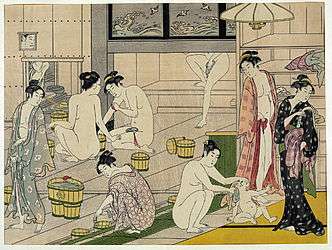Sansuke

Sansuke (三助) are the working staff that provide many services at the Zeniyu (銭湯 public bathhouse) in Japan.
Origin of the word
In Japanese, Sansuke means three types of services: kamataki (stoking of the boiler), yukagen wo miru (checking the temperature of the bath water), and bandai (fee collection). It was an occasional duty for the Sansuke to provide the service of washing off dirt or brushing. For this reason, the image of Sansuke as the service to the visitor in the bathhouse was generalized emphasizing this role.
When smallpox occurred around the Nara era, the Kohmyo Kougou (光明皇后 Empress Kohmyo), the Shohmu Tennoh (聖武天皇 Emperor Shomu) 's empress built the bathhouse and devoid to the treatment of the patients by herself. Three chamberlains helped the Empress during that time. They called them Sansuke (三典), and this name became the origin of Sansuke (三助). [1] During the Edo era, a Genan (下男 manservant), or Komono (小者 humble servant) was wildly described as Sansuke as well.[2]
Sansuke in premodern times
Until the early Edo era, these services were provided by Yuna girls, but gradually it changed to sexual services. At that time, Okami (the government) inhibited these services.
With the prohibition of Yuna girls, the role was replaced by Sansuke boys. Sansuke was a supreme class of male servants who served a master of the zeniyu. To become a sansuke, there were several precursor roles: collector of firewood, boiler man, and Yuban, checker of the bath temperature, and so on.[3] Yuban had the important work of checking the congestion degree of the bath or bathroom in addition to above work and it was possible to become a Sansuke by gaining a lot of experience.[3]
Nagashi
The service of washing off the dirt and brushing done by a Sansuke is Nagashi. When announced by Bandai that there are customers, a Sansuke laves hot water into Oke and calls the customers in. In case there are many customers, the Sansuke must take care of the waiting list and wash the customers swiftly. The Sansuke offers service for both men and women; he may be required to work in crowds of naked woman, whereby he must adopt the mental training to prevent himself from having an erection. [4] It is said that women were not ashamed of his eyes.[4]
When the washing service was done and received a tag from customer, his work was finished. His percentage of pay was based according to the number on the tag.[3] The Sansuke belonged to a higher economic bracket in Sento and were considered to be gentlemen.
Kodakara no yu and Sansuke

In various parts of Japan, there existed Kodakara no Yu (the magical spa where infertile women were able to conceive). Nowadays it is thought the magic was that the Sansuke engaged in sex with a female customer and made her pregnant. If the cause of the woman's inability to conceive was due to the husband's infertility, then the Sansuke would allow for a successful pregnancy to occur.
During the Edo era, people had different priorities. For women, it was of paramount importance to leave the household with a son and heir; thus, they had to become pregnant by some way. A daughter-in-law who had not yet produced a son would be given directions to go Kodakara no yu impliedly by mother-in-law and father.
Sansuke during early-modern times
Aka-suri or massage was called a Nagashi, and it reached heights of prosperity in the middle of the Showa era; during this time it was considered to be a luxury. But due to proliferation of boilers and baths in general households, the need for Sansuke was reduced and the service of Nagashi ebbed. [5]
Sansuke today
According to Shinobu Machida (町田忍), the historian of zeniyu, there is a only sansuke at Saitoh yu (斉藤湯) in Tokyo Japan. His name is Mr. Shusei Tachibana (橘秀雪). He gives service for both men and women now. Of course they do not engage in side work (the pre-modern fertility treatment), they give Akasuri or massage treatment only. At work, Sansuke put on Sarumata (Japanese briefs); in former days, Sansuke put Fundoshi (breechcloth), his style was thought naughty by women. [6]
Reference books
- NHK教育『知るを楽しむ 歴史に好奇心』 あ~極楽の銭湯史- 第3回
- 小野武雄1977『江戸の遊戯風俗図誌』
- 赤松啓介1994『夜這いの民俗学』
- 赤松啓介VS上野千鶴子『猥談 : 近代日本の下半身』
- 吉田忠, 深瀬泰旦編『東と西の医療文化』 -- 思文閣出版, 2001.
- 中野栄三『入浴・銭湯の歴史』雄山閣出版、1984年、(雄山閣BOOKS No.16) ISBN 4-639-00311-0
- 笹川潔 1912 『前小景』 敬文館書房[7]